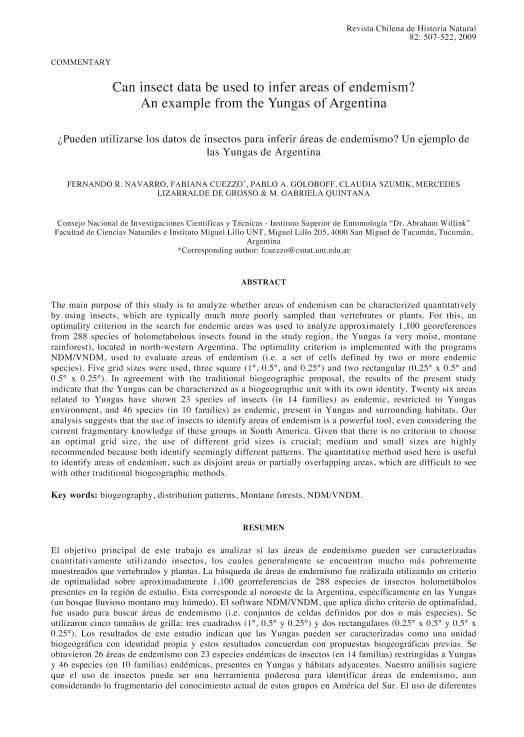Artículo
The main purpose of this study is to analyze whether areas of endemism can be characterized quantitatively by using insects, which are typically much more poorly sampled than vertebrates or plants. For this, an optimality criterion in the search for endemic areas was used to analyze approximately 1,100 georeferences from 288 species of holometabolous insects found in the study region, the Yungas (a very moist, montane rainforest), located in north-western Argentina. The optimality criterion is implemented with the programs NDM/VNDM, used to evaluate areas of endemism (i.e. a set of cells defined by two or more endemic species). Five grid sizes were used, three square (1°, 0.5°, and 0.25°) and two rectangular (0.25° x 0.5° and 0.5° x 0.25°). In agreement with the traditional biogeographic proposal, the results of the present study indicate that the Yungas can be characterized as a biogeographic unit with its own identity. Twenty six areas related to Yungas have shown 23 species of insects (in 14 families) as endemic, restricted to Yungas environment, and 46 species (in 10 families) as endemic, present in Yungas and surrounding habitats. Our analysis suggests that the use of insects to identify areas of endemism is a powerful tool, even considering the current fragmentary knowledge of these groups in South America. Given that there is no criterion to choose an optimal grid size, the use of different grid sizes is crucial; medium and small sizes are highly recommended because both identify seemingly different patterns. The quantitative method used here is useful to identify areas of endemism, such as disjoint areas or partially overlapping areas, which are difficult to see with other traditional biogeographic methods. El objetivo principal de este trabajo es analizar si las areas de endemismo pueden ser caracterizadas cuantitativamente utilizando insectos, los cuales generalmente se encuentran mucho más pobremente muestreados que vertebrados y plantas. La búsqueda de areas de endemismo fue realizada utilizando un criterio de optimalidad sobre aproximadamente 1,100 georreferencias de 288 especies de insectos holometábolos presentes en la región de estudio. Esta corresponde al noroeste de la Argentina, específicamente en las Yungas (un bosque lluvioso montano muy húmedo). El software NDM/VNDM, que aplica dicho criterio de optimalidad, fue usado para buscar areas de endemismo (i.e. conjuntos de celdas definidos por dos o más especies). Se utilizaron cinco tamaños de grilla: tres cuadrados (Io, 0.5° y 0.25°) y dos rectangulares (0.25° x 0.5° y 0.5° x 0.25°). Los resultados de este estudio indican que las Yungas pueden ser caracterizadas como una unidad biogeográfica con identidad propia y estos resultados concuerdan con propuestas biogeográficas previas. Se obtuvieron 26 areas de endemismo con 23 especies endémicas de insectos (en 14 familias) restringidas a Yungas y 46 especies (en 10 familias) endémicas, presentes en Yungas y hábitats adyacentes. Nuestro análisis sugiere que el uso de insectos puede ser una herramienta poderosa para identificar areas de endemismo, aun considerando lo fragmentario del conocimiento actual de estos grupos en América del Sur. El uso de diferentes tamaños de grilla fue crucial. Tamaños pequeños y medianos son altamente recomendados para identificar patrones diferentes. El método cuantitativo utilizado permitió identificar areas de endemismo difíciles de reconocer con métodos biogeográficos tradicionales, tales como areas disyuntas o parcialmente superpuestas.
Can insect data be used to infer areas of endemism? An example from the Yungas of Argentina
Título:
¿Pueden utilizarse los datos de insectos para inferir áreas de endemismo? Un ejemplo de las Yungas de Argentina
Navarro, Fernando Ruben ; Cuezzo, Fabiana del Carmen
; Cuezzo, Fabiana del Carmen ; Goloboff, Pablo Augusto
; Goloboff, Pablo Augusto ; Szumik, Claudia Adriana
; Szumik, Claudia Adriana ; Lizarralde, Mercedes Sara
; Lizarralde, Mercedes Sara ; Quintana, María Gabriela
; Quintana, María Gabriela
 ; Cuezzo, Fabiana del Carmen
; Cuezzo, Fabiana del Carmen ; Goloboff, Pablo Augusto
; Goloboff, Pablo Augusto ; Szumik, Claudia Adriana
; Szumik, Claudia Adriana ; Lizarralde, Mercedes Sara
; Lizarralde, Mercedes Sara ; Quintana, María Gabriela
; Quintana, María Gabriela
Fecha de publicación:
12/2009
Editorial:
Sociedad de Biología de Chile
Revista:
Revista Chilena de Historia Natural
ISSN:
0716-078X
e-ISSN:
0717-6317
Idioma:
Inglés
Tipo de recurso:
Artículo publicado
Clasificación temática:
Resumen
Palabras clave:
Biogeografía
,
Ndm/Vndm
,
Insectos
,
Yungas
,
Bosque Montano
,
Patrones de Distribución
Archivos asociados
Licencia
Identificadores
Colecciones
Articulos(CCT - NOA SUR)
Articulos de CTRO.CIENTIFICO TECNOL.CONICET - NOA SUR
Articulos de CTRO.CIENTIFICO TECNOL.CONICET - NOA SUR
Citación
Navarro, Fernando Ruben; Cuezzo, Fabiana del Carmen; Goloboff, Pablo Augusto; Szumik, Claudia Adriana; Lizarralde, Mercedes Sara; et al.; Can insect data be used to infer areas of endemism? An example from the Yungas of Argentina; Sociedad de Biología de Chile; Revista Chilena de Historia Natural; 82; 4; 12-2009; 507-522
Compartir
Altmétricas



